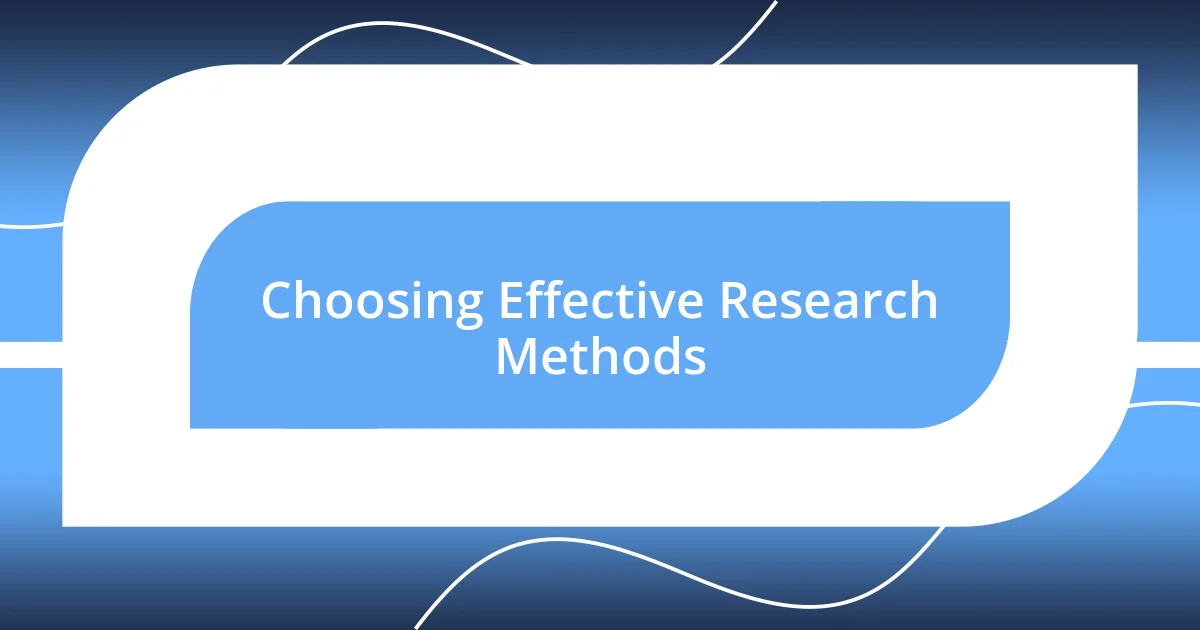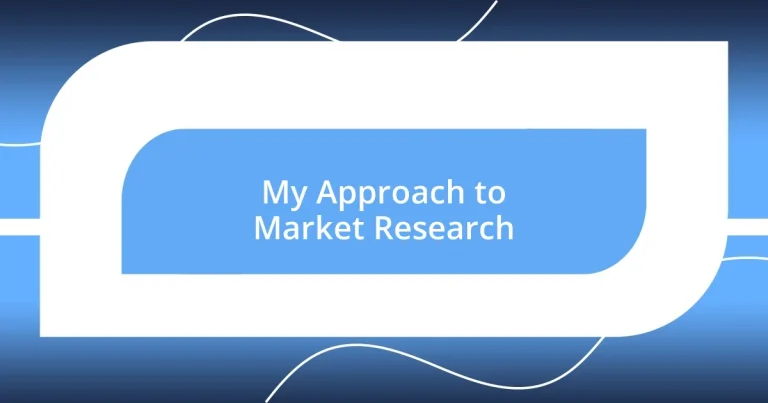Key takeaways:
- Market research blends qualitative and quantitative methods, fostering a deeper understanding of customer insights beyond mere statistics.
- Identifying target market segments through various strategies like demographic analysis and feedback loops enhances tailored marketing efforts and engagement.
- Implementing research findings requires collaboration, adaptability, and continuous monitoring to ensure strategies effectively resonate with the target audience.

Understanding Market Research Fundamentals
Market research is the art of gathering and interpreting data to make informed decisions. I remember the first time I conducted a survey for a product launch; it opened my eyes to customer preferences I hadn’t even considered. Isn’t it fascinating how asking the right questions can uncover insights that drive your business forward?
At its core, market research combines qualitative and quantitative methods. When I was analyzing customer feedback, I found that numbers told part of the story, but personal anecdotes from interviews brought it to life. This blend creates a more comprehensive understanding of your target audience—don’t we all crave a connection beyond the statistics?
Understanding your market fundamentally requires recognizing the shifting dynamics of consumer behavior. I’ve experienced firsthand how quickly trends can change, making continuous research essential. Have you ever felt out of touch with your audience? That’s why staying engaged with research isn’t just about collecting data; it’s about fostering a relationship with your market.

Identifying Target Market Segments
Identifying target market segments is like piecing together a puzzle; each segment is crucial in understanding the whole picture. I recall a project where I had to define customer personas for a new line of organic snacks. By diving into demographics and lifestyle choices, we discovered a segment of health-conscious millennials who valued transparency in sourcing. It was exhilarating to see how identifying this niche allowed us to tailor our marketing messages effectively.
To identify target market segments, consider the following strategies:
- Demographic analysis: Define your audience by characteristics such as age, gender, and income level.
- Psychographic profiling: Explore lifestyle choices, values, and interests that motivate customer purchasing decisions.
- Behavioral segmentation: Look at purchasing habits and usage patterns, like how often and why consumers choose your product.
- Geographic targeting: Assess location-based trends and preferences, which can greatly influence consumer behavior.
- Feedback loops: Regularly engage with your audience for insights and evolving needs, ensuring you stay aligned with market shifts.
These methods have always opened new avenues for me in understanding who exactly I’m speaking to, ultimately leading to more authentic engagement.

Choosing Effective Research Methods
When it comes to choosing effective research methods, it’s essential to align them with the specific goals of your project. I once found myself in a situation where I relied solely on surveys for customer insights. While they provided valuable data, I quickly realized that focus groups could’ve added depth—allowing customers to express emotions and experiences that numbers alone couldn’t convey. That’s when it struck me: different methods illuminate different facets of a market.
Utilizing a mix of qualitative and quantitative approaches is like adding colors to a canvas. During one project, my team used online polls to gauge customer preferences but supplemented that with in-depth interviews. The combination revealed not just what customers wanted, but why they felt that way. Can you imagine how enriching it is to witness your audience’s stories unfold? It’s this interplay that leads to more profound insights and lasting brand connections.
Choosing the right research method also hinges on resources available, including time and budget. For instance, I had a tight deadline for a campaign and opted for social media analytics instead of traditional focus groups. While it was effective for quick insights, I later realized the richness of narratives I might have missed. This experience taught me that effective research is not only about efficiency but also about ensuring you capture the complete picture of your audience’s thoughts and experiences.
| Research Method | Advantages |
|---|---|
| Surveys | Quick to gather large amounts of data; easy to analyze statistically. |
| Focus Groups | Provide rich qualitative insights and reveal customer emotions. |
| Interviews | Allow for in-depth exploration of individual experiences and motivations. |
| Social Media Analytics | Offer real-time insights and reflect current trends rapidly. |
| Case Studies | Demonstrate practical applications and successful strategies in real-world scenarios. |

Collecting and Analyzing Data
When collecting data, I often find that the method I choose can significantly impact the insight I gain. For example, one time, I rolled out customer surveys, only to realize that they often produced sterile responses. I learned that a casual conversation, perhaps over coffee, could unlock deeper insights. Have you ever had a chat that made you see things from a different perspective? That’s the magic of personal engagement.
As I analyze the data I’ve collected, I lean heavily on visualization tools. During a past project, I used heat maps to illustrate online shopping patterns, revealing surprising trends about peak usage times. Seeing those patterns visually made it easier for my team to strategize effectively. Why rely on just numbers when visuals can narrate the story behind them? This taught me the value of translating raw data into something digestible and actionable.
Finally, embracing a flexible mindset while analyzing data is crucial. I remember a project where initial findings led us down one path, but a second look unveiled unexpected correlations. Sometimes, your data might take you in directions you didn’t anticipate, and that’s okay! Have you experienced a dataset that shifted your entire approach? In those moments, the willingness to pivot is key to data-driven success.

Interpreting Research Results
Interpreting research results can often feel like piecing together a puzzle. I remember a time when I gathered extensive data on consumer behavior, only to find that the results were mixed and somewhat confusing. It was only after diving deeper, categorizing feedback based on demographics and motivations, that I began to see clarity. Have you ever found yourself staring at a jumble of data, unsure of what it all means? Sometimes, breaking it down into smaller, manageable segments can reveal insights that are right under your nose.
I also emphasize the importance of context when interpreting findings. For instance, in one project, we discovered that sales dipped during a specific season. Initially, this seemed alarming until we examined external factors, like economic trends and holiday shopping habits. This broader perspective transformed a potential setback into an opportunity for strategic planning. Have you considered how external influences might shape your data? Understanding these layers can provide a richer, more nuanced interpretation of your results.
Lastly, I’ve learned to trust my intuition alongside the statistics. In a recent analysis, although numbers suggested one direction, my gut hinted at another. When we decided to follow that instinct and pivot our strategy, the outcome exceeded our expectations. Isn’t it fascinating how combining analytical insight with personal intuition can lead to unexpected breakthroughs? Balancing data with instinct often leads to more informed, confident decision-making.

Implementing Findings for Strategy
Implementing research findings into strategic decisions is a crucial part of my work. I recall a scenario where we had gathered extensive feedback on product features that customers valued the most. Instead of simply presenting the data to the team, I facilitated a brainstorming session where we could explore these findings together. This collaborative atmosphere sparked creativity, leading us to prioritize certain features in our next update that we might not have otherwise considered. Have you ever witnessed a moment when teamwork transformed data into a powerful strategy?
I also recognize that the implementation phase can be challenging; it’s often where good plans start to show cracks. For instance, after concluding that our audience favored online interactions, we decided to enhance our digital marketing efforts significantly. However, we soon learned that the execution resonated differently than anticipated. Adjustments were needed, and having an open dialogue with the team helped us stay agile. Isn’t it insightful how real-world application sometimes diverges from theoretical findings?
Moreover, I find that it’s essential to keep monitoring the outcomes post-implementation. After launching our revised strategy, we created a feedback loop to assess its effectiveness continuously. One time, we discovered that our adapted communications weren’t engaging as intended. By addressing the issue promptly and adjusting our messaging, we improved engagement rates significantly. This experience demonstrated the power of adaptability—how ongoing adjustments can lead from data insights to actionable improvements. Do you agree that real success often lies in our willingness to learn and refine as we go?














